 W
WAlexios III Angelos was Byzantine Emperor from March 1195 to 17/18 July 1203. A member of the extended imperial family, Alexios came to throne after deposing, blinding and imprisoning his younger brother Isaac II Angelos. The most significant event of his reign was the attack of the Fourth Crusade on Constantinople in 1203, on behalf of Alexios IV Angelos. Alexios III took over the defence of the city, which he mismanaged, and then fled the city at night with one of his three daughters. From Adrianople, and then Mosynopolis, he attempted unsuccessfully to rally his supporters, only to end up a captive of Marquis Boniface of Montferrat. He was ransomed, sent to Asia Minor where he plotted against his son-in-law Theodore Laskaris, but was eventually captured and spent his last days confined to the Monastery of Hyakinthos in Nicaea, where he died.
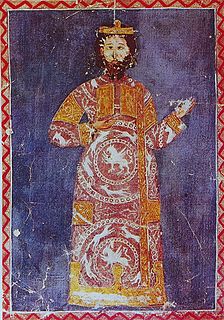 W
WAlexios V Doukas, in Latinised spelling Alexius V Ducas, was Byzantine emperor from 5 February to 12 April 1204, just prior to the sack of Constantinople by the participants of the Fourth Crusade. His family name was Doukas, but he was also known by the nickname Mourtzouphlos or Murtzuphlus (Μούρτζουφλος), referring to either bushy, overhanging eyebrows or a sullen, gloomy character. He achieved power through a palace coup, killing his predecessors in the process. Though he made vigorous attempts to defend Constantinople from the crusader army, his military efforts proved ineffective. His actions won the support of the mass of the populace, but he alienated the elite of the city. Following the fall, sack, and occupation of the city, Alexios V was blinded by another ex-emperor and later executed by the new Latin regime. He was the last Byzantine emperor to rule in Constantinople until the Byzantine recapture of Constantinople in 1261.
 W
WAlexios IV Angelos or Alexius IV Angelus was Byzantine Emperor from August 1203 to January 1204. He was the son of Emperor Isaac II Angelos and his first wife, an unknown Palaiologina, who became a nun with the name Irene. His paternal uncle was his predecessor Emperor Alexios III Angelos.
 W
WBaldwin I was the first emperor of the Latin Empire of Constantinople; Count of Flanders from 1194-1205 and Count of Hainaut from 1195-1205. Baldwin was one of the most prominent leaders of the Fourth Crusade, which resulted in the sack of Constantinople in 1204, the conquest of large parts of the Byzantine Empire, and the foundation of the Latin Empire. He lost his final battle to Kaloyan, the emperor of Bulgaria, and spent his last days as his prisoner.
 W
WLouis I of Blois was Count of Blois from 1191 to 1205. He was the son of Theobald V and Alix of France. His maternal grandparents were Louis VII of France and his first wife, Eleanor of Aquitaine. Whilst in his teens, Louis joined his father on the Third Crusade.
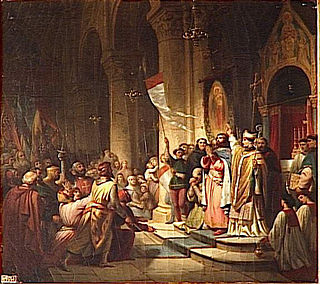 W
WBoniface I, usually known as Boniface of Montferrat, was the ninth Marquis of Montferrat, the leader of the Fourth Crusade (1201–04) and king of Thessalonica.
 W
WMichael Choniates, Byzantine writer and ecclesiastic, was born at Chonae. At an early age he studied at Constantinople and was the pupil of Eustathius of Thessalonica. Around 1175 he was appointed archbishop of Athens, a position which he retained until 1204. In 1204, he defended the Acropolis of Athens from attack by Leo Sgouros, holding out until the arrival of the Crusaders in 1205, to whom he surrendered the city. After the establishment of Latin control, he retired to the island of Ceos. Around 1217 he moved again to the monastery of Vodonitsa near Thermopylae, where he died.
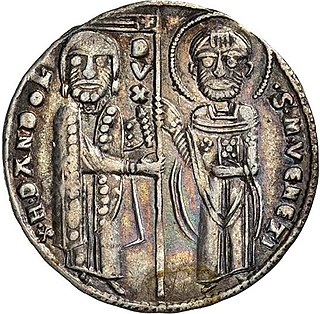 W
WEnrico Dandolo was the 41st Doge of Venice from 1192 until his death. He is remembered for his avowed piety, longevity, and shrewdness, and is known for his role in the Fourth Crusade and the Sack of Constantinople.
 W
WElias Cairel was a troubadour of international fame. Born in Sarlat in the Périgord, he first travelled with the Fourth Crusade and settled down in the Kingdom of Thessalonica at the court of Boniface of Montferrat (1204–1208/10) before moving back to western Europe, where he sojourned at the court of Alfonso IX of León (1210–11) and in Lombardy (1219–1222/24). He wrote fourteen surviving lyrics: ten cansos, one tenso, one descort, one sirventes, and one Crusade song. He was partial to refrain rhyming and coblas capfinidas.
 W
WFernando Afonso (1135–1207), was Grand Master of the Knights Hospitaller between 1202-1206. He was the oldest son of Afonso Henriques, the first king of the Kingdom of Portugal, though would never inherit the crown as he was born out of wedlock.
 W
WFulk of Neuilly was a French preacher of the twelfth century, and priest of Neuilly-sur-Marne. His preaching encouraged the Fourth Crusade. He is a beatus of the Roman Catholic Church; his feast is celebrated on March 2.
 W
WGaucelm Faidit was a troubadour, born in Uzerche, in the Limousin, from a family of knights in service of the count of Turenne. He travelled widely in France, Spain, and Hungary. His known patrons include Geoffrey II, Duke of Brittany and Dalfi d'Alvernha; he was at one time in Poitiers at the court of Richard I of England, for whose death he wrote a famous planh (lament) in 1199. It is possible, but controversial, that Gaucelm took part in the Third Crusade from 1189–1191; it seems clear that in 1202 he set out on the Fourth Crusade, as did his current patron, Boniface of Montferrat. After 1202 there is no further historical trace of him.
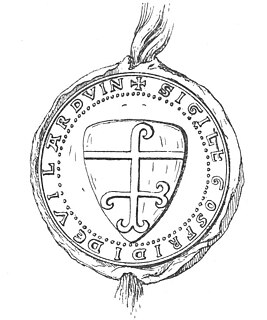 W
WGeoffrey I of Villehardouin was a French knight from the County of Champagne who joined the Fourth Crusade. He participated in the conquest of the Peloponnese and became the second prince of Achaea.
 W
WGeoffrey V, nicknamed le Trouillard, was the Lord of Joinville from 1190 until his death in late 1203 or early 1204. He was also the hereditary seneschal of the County of Champagne. He went on both the Third Crusade (1189–90) and the Fourth Crusade (1202–04), where he died.
 W
WAndrea Ghisi was a Venetian nobleman, and the first Lord of Tinos and Mykonos.
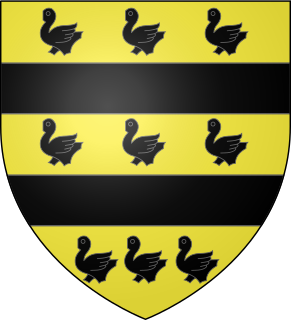 W
WGuillaume de Ferrières, Vidame de Chartres was a French nobleman, probably the same person as the trouvère whose works are recorded only as by the Vidame de Chartres, his title. Eight songs in total have been attributed to the Vidame, though all but one with conflicting attributions to others. He is not to be confused with Raoul de Ferrières, also a trouvère.
 W
WHenry was the second Latin Emperor of Constantinople. He was a younger son of Baldwin V, Count of Hainaut, and Margaret I of Flanders, sister of Philip of Alsace, count of Flanders.
 W
WHugues IV de Berzé was a knight and trouvère from the Mâconnais. He participated in the Fourth Crusade in 1201 and the Fifth Crusade in 1220. He was the lord of Berzé-le-Châtel.
 W
WPope Innocent III, born Lotario dei Conti di Segni, held office from 8 January 1198 to his death.
 W
WIsaac II Angelos was Byzantine Emperor from 1185 to 1195, and again from 1203 to 1204.
 W
WSimon de Montfort, 5th Earl of Leicester, known as Simon IV de Montfort and as Simon de Montfort the Elder, was a French nobleman and famed knight of the early 13th century. He is widely regarded as one of the great military commanders of the Middle Ages. He took part in the Fourth Crusade and was one of the prominent figures of the Albigensian Crusade. Montfort is mostly noted for his campaigns in the latter, notably for his triumph at Muret. He died at the Siege of Toulouse in 1218. He was lord of Montfort-l'Amaury from 1188 to his death and Earl of Leicester in England from 1204. He was also Viscount of Albi, Béziers and Carcassonne from 1213, as well as Count of Toulouse from 1215.
 W
WPeter of Capua was an Italian theologian and scholastic philosopher, and a Cardinal and papal legate.
 W
WPeter was an Italian Cistercian monk and prelate. He was the abbot of Rivalta from 1180 until 1185, abbot of Lucedio from 1185 until 1205, abbot of La Ferté from 1205 until 1206, bishop of Ivrea from 1206 until 1209 and patriarch of Antioch from 1209 until his death. He is known as Peter of Magnano, Peter of Lucedio or Peter of Ivrea.
 W
WRenard II, also spelled Reynald, Raynald, Rainard or Renaud, was the count, or lord, of Dampierre-le-Château in the Astenois. His lordship lay partly within the Holy Roman Empire, but he was also a direct vassal of the Count of Champagne.
 W
WOthon de la Roche, also Otho de la Roche, was a Burgundian nobleman of the De la Roche family from La Roche-sur-l'Ognon. He joined the Fourth Crusade and became the first Frankish Lord of Athens in 1204. In addition to Athens, he acquired Thebes by around 1211.
 W
WStephen du Perche was a French nobleman and crusader. He was a partisan of the Plantagenets in their conflict with the French crown and held fiefs from them. A younger son, he governed the County of Perche on behalf of his father and brother during their absence on crusade. He himself joined the Fourth Crusade in 1202 and travelled to the Holy Land. Afterwards, he went to the Latin Empire and was appointed duke of Philadelphia in Asia Minor in 1204. He died in battle against the Bulgars.
 W
WTheobald III of Champagne was Count of Champagne from 1197 to his death. He was the younger son of Henry I, Count of Champagne and Marie, a daughter of Louis VII of France and Eleanor of Aquitaine. He succeeded as Count of Champagne in 1197 upon the death of his older brother Henry II.
 W
WRaimbaut de Vaqueiras or Vaqueyras was a Provençal troubadour and, later in his life, knight. His life was spent mainly in Italian courts until 1203, when he joined the Fourth Crusade. His writings, particularly the so-called Epic Letter, form an important commentary on the politics of the Latin Empire in its earliest years. Vaqueiras's works include a multilingual poem, Eras quan vey verdeyar where he used French, Italian, Galician-Portuguese and Gascon, together with his own Provençal.
 W
WWilliam II, Lord of Béthune, nicknamed William the Red was French nobleman. He was a ruling Lord of Béthune, Richebourg and Warneton, as well as hereditary advocatus of the Abbey of St. Vaast, near Arras.
 W
WWilliam I of Champlitte (1160s-1209) was a French knight who joined the Fourth Crusade and became the first prince of Achaea (1205–1209).